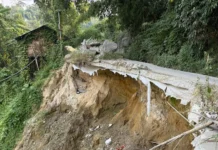NEW DELHI, 5 Oct: The working conditions of teachers in the Northeast and ‘aspirational districts’ are poor and there is a marked rural-urban disparity in terms of basic amenities as well as information and communications technology (ICT) infrastructure, according to a UNESCO report.
The report, titled ‘2021 state of the education report for India: No teacher, no class’, also states that while teacher availability has improved, pupil-teacher ratios are still adverse in secondary schools.
The teaching workforce has a deficit of over 1 million teachers at current student strength and the need is likely to grow, given the shortages of teachers in certain education levels and subjects such as early childhood education, special education, physical education, music, arts, and curricular streams of vocational education, the report says.
“In fifteen years, about 30 percent of the current workforce will need to be replaced,” it said.
“There is a pronounced need to improve both availability and deployment of qualified teachers in the northeastern states of India. In terms of basic amenities, the working conditions of teachers in the Northeast and the aspirational districts are poor. Provision of school libraries is low, ICT infrastructure is very low, and there is marked rural-urban disparity.
“While teacher availability has improved, pupil-teacher ratios are adverse in secondary schools. Moreover, there is no information on availability of special education, music, arts and physical education teachers. The availability and deployment of subject teachers, too, is not well documented and monitored.
Almost all single-teacher schools are in rural areas,” the report said.
The report, released by the United Nations Educational, Scientific and Cultural Organization (UNESCO), has noted that the teaching profession has “average status” in India, but it is a career of choice for women and youths from rural areas in particular.
“Private school teachers and early childhood education teachers are highly vulnerable groups, with many working without contracts at low salaries, with no health or maternity leave benefits,” it said.
Calling for more “professional autonomy” for teachers, the report said, “Teacher workload is high – contrary to public perception – although invisible, and a source of stress. Teachers value being given professional autonomy, and disregard of this is demotivating.”
“Teachers’ voices in the system in matters of policy and governance can be enhanced through professional teacher networks, and unions. Most accountability systems tend to emphasize monitoring. Professional standards need to be made a part of a larger system and used in the context of professional development rather than accountability,” it added.
The report, prepared using data from the unified district information system for education (UDISE), has also found that the Covid-19 pandemic has exposed the vulnerability and insecurity of teachers.
“The profession is overall gender balanced, with women accounting for about 50 percent of the teaching workforce, but there are significant interstate and urban-rural variations,” it said.
“Special attention needs to be paid to rural areas, districts with high scheduled caste and tribe populations, and all across India’s Northeast, where the ratio of teachers to students needs to improve and be rationalized. Working conditions in these ‘difficult to staff’ regions also need to be improved. More state support for teacher education programmes is desirable in these regions,” the report recommended. (PTI)



